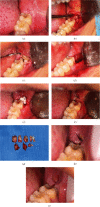A Rare Case of Concrescence of Mandibular Third Molar and Supernumerary Fourth Molar
- PMID: 36090692
- PMCID: PMC9452987
- DOI: 10.1155/2022/3771299
A Rare Case of Concrescence of Mandibular Third Molar and Supernumerary Fourth Molar
Abstract
Concrescence reveals a rare developmental anomaly in which two fully formed teeth are joined along the root surfaces by cementum, and generally occurs in maxillary molars, especially in a third molar and a supernumerary tooth. Very few cases have been reported about the concrescence of a third molar and a supernumerary fourth molar. Based on our available knowledge, this case report described a rare presentation in which concrescence is observed between a third molar and a supernumerary fourth molar in the mandible by diagnosing with cone-beam CT and histological examination.
Copyright © 2022 Jiao Wang et al.
Conflict of interest statement
The authors declare that they have no conflicts of interest.
Figures




Similar articles
-
Concrescence of a mandibular third molar and a supernumerary fourth molar: report of a rare case.Br Dent J. 2006 Feb 11;200(3):141-2. doi: 10.1038/sj.bdj.4813191. Br Dent J. 2006. PMID: 16474352
-
Endodontic microsurgery and prosthodontic treatment of a permanent anterior concrescence: A case report.J Pak Med Assoc. 2024 Jul;74(7):1367-1369. doi: 10.47391/JPMA.10394. J Pak Med Assoc. 2024. PMID: 39028074
-
Concrescence of maxillary second molar and impacted third molar: A case report.World J Clin Cases. 2022 Oct 6;10(28):10286-10292. doi: 10.12998/wjcc.v10.i28.10286. World J Clin Cases. 2022. PMID: 36246819 Free PMC article.
-
Bilateral maxillary and mandibular fourth molars: a case report and literature review.J Investig Clin Dent. 2011 Nov;2(4):296-9. doi: 10.1111/j.2041-1626.2011.00075.x. Epub 2011 Jun 24. J Investig Clin Dent. 2011. PMID: 25426903 Review.
-
Concrescence: report of a rare case.Oral Surg Oral Med Oral Pathol Oral Radiol Endod. 2004 Mar;97(3):325-7. doi: 10.1016/j.tripleo.2003.10.015. Oral Surg Oral Med Oral Pathol Oral Radiol Endod. 2004. PMID: 15024354 Review.
References
Publication types
LinkOut - more resources
Full Text Sources

